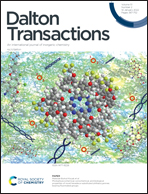Defect-related luminescence behavior of a Mn4+ non-equivalently doped fluoroantimonate red phosphor†
Abstract
Non-equivalent or non-octahedral substitution is a crucial strategy to gain Mn4+-doped fluoride red phosphors with a short fluorescence lifetime, whereas the impact of their structural defects on the photoluminescence (PL) properties remains unrevealed. Here, a non-equivalently doped RbSbF6:Mn4+ (RSFM) with a high quantum efficiency of 88% and a thermal stability of 121% at 425 K is newly reported to probe the defect-related PL behavior. Formation energy calculations imply that an interstitial defect  was formed to balance the charge and stabilize the crystal structure. Concentration-dependent decay studies reveal that Mn4+ emission is quenched mainly by energy transfer to a neighboring defect
was formed to balance the charge and stabilize the crystal structure. Concentration-dependent decay studies reveal that Mn4+ emission is quenched mainly by energy transfer to a neighboring defect  . The large ionic radius of Sb5+ and defect
. The large ionic radius of Sb5+ and defect  leading to a premature optimal doping (0.11 mol%) is demonstrated by the refined contrast of the crystal structure and substitution mode among various Mn4+-doped prototypes. A couple of medium 4T2 state energies and the energy difference between the Mn4+ level with the valence band maximum enable its superior thermal stability. A higher defect concentration slightly aggravates this thermal quenching. Using the RSFM red phosphor in a white light-emitting diode offers a wide-color-gamut of 121% NTSC for backlight displays. This work would provide a new perspective to understand the defect effect on the PL behavior of special Mn4+ asymmetrically doped fluorides.
leading to a premature optimal doping (0.11 mol%) is demonstrated by the refined contrast of the crystal structure and substitution mode among various Mn4+-doped prototypes. A couple of medium 4T2 state energies and the energy difference between the Mn4+ level with the valence band maximum enable its superior thermal stability. A higher defect concentration slightly aggravates this thermal quenching. Using the RSFM red phosphor in a white light-emitting diode offers a wide-color-gamut of 121% NTSC for backlight displays. This work would provide a new perspective to understand the defect effect on the PL behavior of special Mn4+ asymmetrically doped fluorides.



 Please wait while we load your content...
Please wait while we load your content...